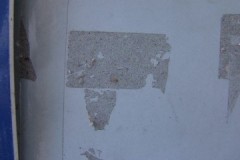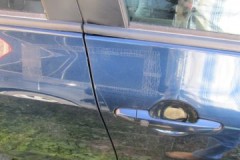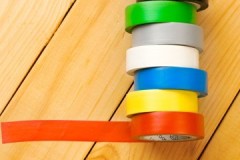Top 9 most effective ways to remove double-sided tape
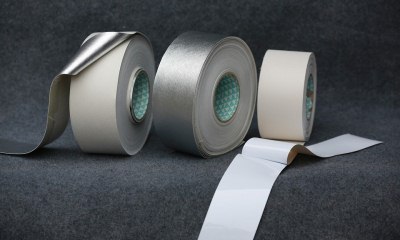 Getting rid of the remaining adhesive tape is not easy. For example, washing it off with ordinary soapy water is unlikely to work.
Getting rid of the remaining adhesive tape is not easy. For example, washing it off with ordinary soapy water is unlikely to work.
But effective ways to deal with scotch tape and traces of it still exist.
We will tell you how and how to remove double-sided tape from various surfaces in the article.
Content
How to remove?
Before proceeding with the removal of double-sided tape, you must carefully read the instructions and tips for removal, because any careless movement can ruin the surfacewith traces of scotch tape.
There are dozens, maybe hundreds, of methods for removing sticky marks, but the most effective ones are disclosed below. Let's consider each of them in more detail.
Stationery knife
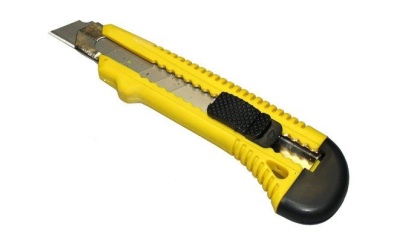 The method is simple, but it is acceptable to use it if the probability of scratching the surface is minimal... You should proceed with caution.
The method is simple, but it is acceptable to use it if the probability of scratching the surface is minimal... You should proceed with caution.
The paper or film base is pushed off with a blade. The loose edge of the tape is easily torn off by hand.
If you did not succeed in removing all the adhesive tape at once, and there are pieces left, you must again raise the edge of the adhesive tape with the edge of a knife, and so on until it is completely removed.
Rubber (rubber) disc
Chip tape off a large area a soft attachment for a drill or screwdriver will help... The rubber disc will remove the top sticky layer without leaving any scratches on the surface.
The tool must be set to minimum speed. Plastic rubber will not harm even the paintwork.
Hair dryer
Glue heated to 80-100 ° C is removed faster. You can use both a construction and a hair dryer for drying hair. It is allowed to replace them with an iron set at the minimum temperature.
The advantage of this method is the absence of scratches even on paper.... The tightest adhesive tape can be removed easily.
But it is not necessary to heat non-heat-resistant objects to high temperatures, especially with the help of a powerful building hair dryer - they immediately deform.Better to put them out in the sun for a while or hold them under steam - the glue will soften noticeably.
Oil
The glue will slip easily if you smear the place of pollution with vegetable or essential (for example, eucalyptus) oil.... They contain organic unsaturated acids that can liquefy polymers:
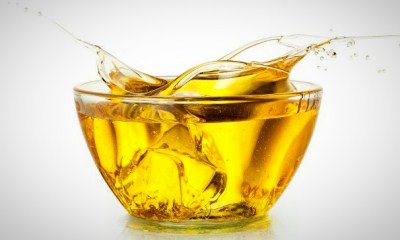 Wipe the sticky surface with a sponge and leave for several hours.
Wipe the sticky surface with a sponge and leave for several hours.- On a horizontal tabletop or bedside table, you can spread a cloth soaked in oil for 20 minutes.
- If the stain is stubborn, it is best to leave the greased stain on overnight. In the morning, the stain will come off effortlessly.
- It remains only to wash off the oil. Easily washable surfaces (glass, polished furniture, plastic) do not absorb grease, so there will be no problems.
This method is not acceptable for paper wallpapers.
Eraser
If you rub the remaining glue with a regular eraser, it will collect into pellets and come off easily... It is enough to rub it with a rag.
Gasoline, acetone, white spirit
The main advantage of this method is the ease and speed of removal:
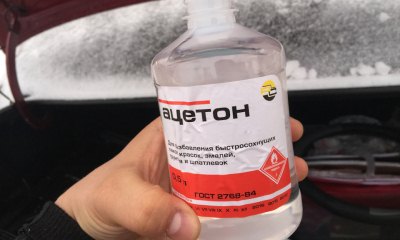 Dampen the cloth with any of the existing solvents and rub the stain.
Dampen the cloth with any of the existing solvents and rub the stain.- Consider the type of surface. Regular gasoline can leave greasy stains behind.
It is better to replace it with a highly purified composition, for example, a liquid intended for refueling Zippo lighters.
- Acetone easily dissolves paint and varnish, therefore it is not recommended to use it for cleaning furniture. Likewise, for removing wallpaper stains.
- All types of surfaces are treated with white spirit, with the exception of those painted with unstable dyes.
Glass cleaner
Most are made with alcohol, which is an excellent solvent:
- It is necessary to rub the stain with a sponge or rag soaked in such a composition, and after a couple of minutes there is no trace of the sticky spot.
- You can replace the wiper with regular drinking or ammonia. They will even cope with dried, old stains.
- More serious means are car glass cleaners. But it should be noted that, in addition to alcohol, they contain rather strong chemical reagents and ammonia.
Table vinegar or citric acid
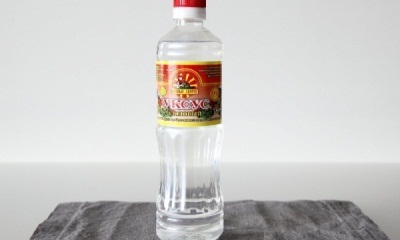 Any acid can dissolve the glue... In everyday life, vinegar or lemon is more often used.
Any acid can dissolve the glue... In everyday life, vinegar or lemon is more often used.
You should rub the contaminated area with citric acid soaked in vinegar or diluted water, and the dirt will easily come off.
This method has a significant advantage: acid does not leave streaks... The smell of vinegar will disappear in just half an hour.
Baking soda
The procedure is valid for hard surfaces such as plastic or tiles. After all, soda particles are, albeit small, but an abrasive that can leave scratches. For cleaning furniture and even more so wallpaper, the method is unacceptable.
The glue will quickly collect into pellets. Replace soda with acceptable tooth powder.
Features of cleaning traces depending on the type of surface
Before you start dealing with the scotch residue, you should consider which of the methods will be not only more effective, but also the safest and most gentle. It can be different for each type of surface.
Glass, mirror
Any method of removal will work, except using abrasives, metal brushes, because scratching the glass surface is not difficult:
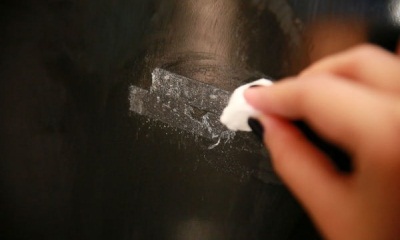 The heating is admittedly small, so a building hair dryer will not work here. Otherwise, the glass product will simply crack.
The heating is admittedly small, so a building hair dryer will not work here. Otherwise, the glass product will simply crack.- You can use oil, alcohol, solvents or glass cleaners.
- Baking soda, a mild abrasive, and a school eraser will not leave visible marks on glass or mirrors.
- The paper tape can be soaked in hot water beforehand to remove the top paper layer.
Learn more about how to remove scotch tape residues from glass. here.
Plastic
It's even easier to damage it than glass, so no brushes or scrapers... It is also not necessary to warm up polymer products - some types of plastic at elevated temperatures can lose their shape and warp.
Learn more about removing adhesive tape from plastic surfaces - here.
Tree
When transporting furniture, adhesive tape is often used. After all, it is so convenient to fix the doors striving to open with it. But then the torment sets in. It seems that the tape has stuck tightly to the smooth surface.
How to remove from wood:
-
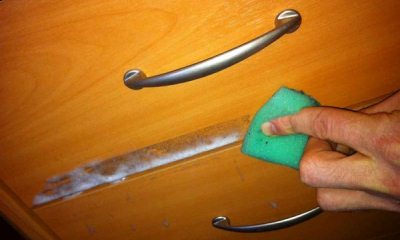 Both polished and unlacquered wood are quite moody. The heating method will not work here.
Both polished and unlacquered wood are quite moody. The heating method will not work here.The varnish will crack when exposed to high temperatures. In this case, it is not necessary to use reactive reagents and solvents.
- The ideal method for cleaning varnished surfaces from glue residues is vegetable or essential oil, alcohol or glass cleaner. They will not leave any marks on the surface.
- It is forbidden to use vegetable oil only on unvarnished wood - the fat is easily absorbed into it.
- You can rub the contaminated area with refined gasoline. It is unable to dissolve varnish and paint.
- Small areas can be easily dealt with with a rubber eraser. A dry rag will help to completely remove the remaining adhesive tape.
Learn more about how to clean the scotch tape and its remains from furniture - in this article.
Laminate
Even a coating of high wear resistance can be damaged by an overly sharp blade. It is even easier to scratch a regular laminated panel with a knife. So no knives.
It is also prohibited to treat the surface with a solvent to avoid removing the polymer coating.
Since the laminate does not tolerate a large amount of water, this is done with a slightly damp cloth,
Painted or papered walls
Removing tape from such a surface is the most problematic. It will be removed together with paper, acrylic or water-based emulsion. It is especially difficult to remove it from uneven, uneven surfaces.
First, the glue is softened with an iron: it should be warm, but not hot... Pat the problem area through cheesecloth or a thin tissue. The softened tape will come off easily.
General Tips
For those who are often faced with the need to remove glue residues, there are several useful recommendations:
 when gluing adhesive tape to a painted surface, you need to be prepared for the fact that this area will brighten a little over time;
when gluing adhesive tape to a painted surface, you need to be prepared for the fact that this area will brighten a little over time;- fresh traces of glue are much easier to remove than old ones;
- solvent 646, in addition to ethers and alcohols, contains acetone; such a mixture will cope with all types of glue;
- there are special products on sale for removing adhesive tape, for example, Label Remover; you need to look for them in hardware stores;
- liquid for starting a fire will also help to remove the remnants of adhesive tape; however, it is only capable of dissolving certain types of adhesives;
- you can replace acetone with a more gentle composition - nail polish remover.
Useful video
How easy it is to wipe off double-sided tape, the video will tell you:
Conclusion
Getting rid of the remaining adhesive tape is real... With a certain skill, even old, sun-dried scotch tape can be removed.
The main thing is to determine the type of surface and use a suitable agent in composition. You can use one or several methods.

